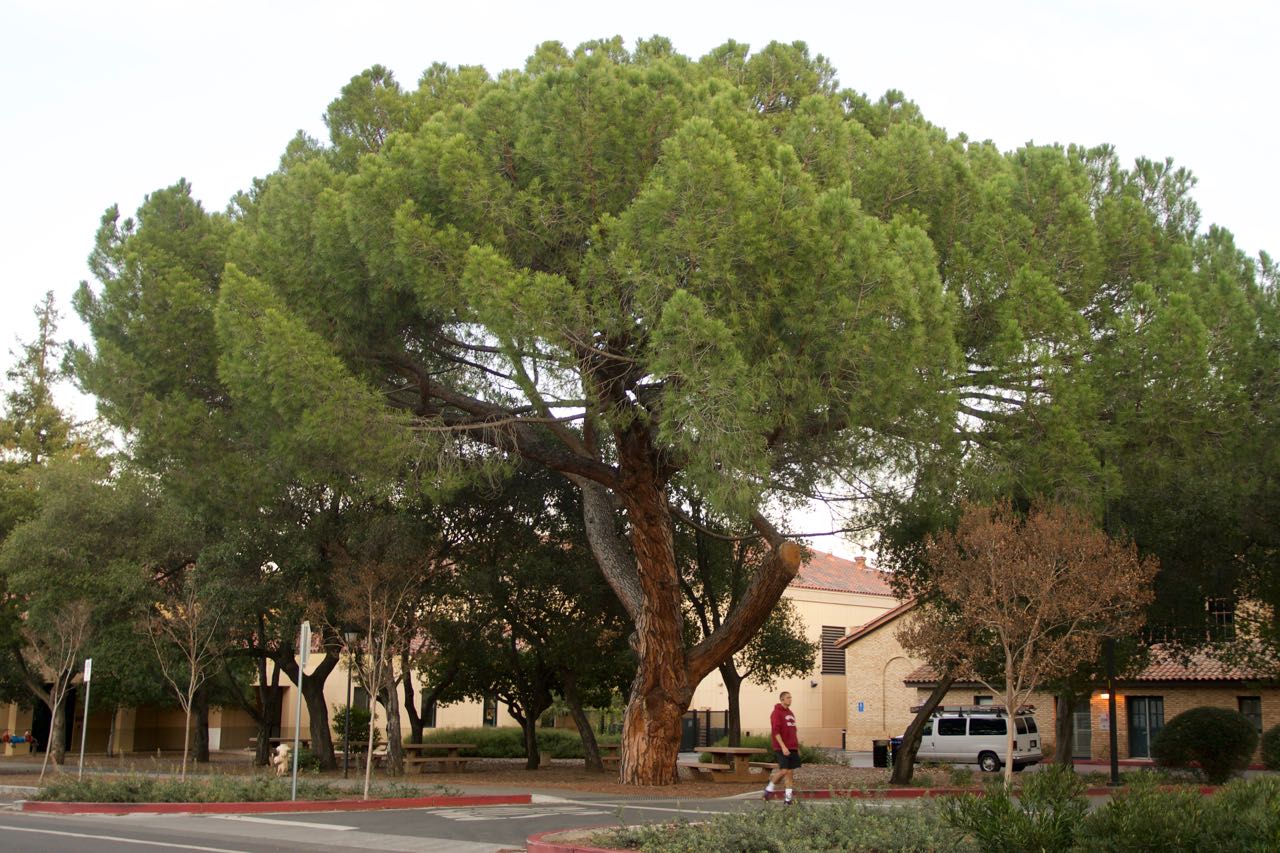Pinus pinea
 Italian stone pine
Italian stone pine
An attractive tree of very characteristic round-topped shape, and without an apical leader except when young. The very hard-shelled nut accounts for the English name stone pine (the Italian name is pino domestico), though the rounded canopy is somewhat like a stone. In its natural distribution the tree hugs the entire north Mediterranean coast from Portugal to Lebanon, though there is some doubt as to whether it is indigenous to the Eastern Mediterranean. The needles are in twos, 5 to 8 inches long, while the cones are about 5 inches long with blunt scales. Widely planted around the world, including its native region, the stone pine cannot now be found in stands definitely known to be natural.
It is extensively used on campus, for example behind the church. An impressive older specimen (12 feet in girth) stands on Galvez Street outside the Burnham Pavilion, and another farther along Galvez Street in the lawn behind the Arrillaga Alumni Center. There is one at 762 Dolores Street. Six old ones used to shelter Roos Brothers men’s store in the 1950s between the Bookstore and 505 Lasuen Mall (which used to be the Career Development Center, and before that was the Bookstore and also accommodated a cobbler once upon a time). They were removed in 2023. Three big specimens northwest of Green Earth Sciences that date back to expansion of the High Energy Physics Lab in the 1960s – and that bear delicious nuts – were supplemented by a further seven when Green Earth Sciences was built.
Twenty large specimens were planted in what was called Stone Pine Plaza in the emerging Science and Engineering Quad in 1999, just west of Moore Materials Research (map pin), but removed nine years later as that quad expanded in scope. Birds, most likely the Western scrub jay, disperse the seeds. Now and then a sapling volunteer can be seen. Squirrels and other rodents race to devour the seeds, which have insignificant wings, unlike many pines whose seed wings are clearly helpful in dispersing the seeds as they fall from the tree tops on windy days.
Pinus monophylla, which grows from Eastern California into the Great Basin, and Pinus edulis, which grows in a few desert ranges in Southeastern California, yield a bountiful crop of nutritious kernels that provided a staple for Native Americans, and wild nuts are still collected today. The P. pinea nuts are known as pinóli, pignóli (which also means persnickety), or sometimes pinóchi, in Italy, where they are much used in pastries and vegetarian dishes. Evidently Pinocchio was a pine nut. The non-Italian word Pignolia is mentioned as a trade name in Webster’s Dictionary of 1929 and currently attaches to pine kernels imported from Pakistan and China.
Why should this pine be broad and rounded like a stone, while other pines are narrow and taper upwards to an apex? As a rule, flowering trees spread their crowns, while conifers tend to rise above them as conical spires; we may accept this distinction as one of the many differences, in leaves, fruit, and wood for instance. But why should a pine be not like other pines? Perhaps the stone pine evolved from ancestors that received sunlight falling from high in the sky, while other pines disposed their foliage on tall masts suited to collecting light from a sun that did not rise very much above the horizon.
· A simple key to campus pines
Name derivation: Pinus – Latin for pine; pinea – Latin for pine nut.
About this Entry: The main text of this entry (other than the Notes section) is from the book Trees of Stanford and Environs, by Ronald Bracewell, published 2005. John Rawlings subsequently added a footnote with comments from Michael Geordie. Seed dispersal notes, location updates, other edits (Oct 2024, SP).




